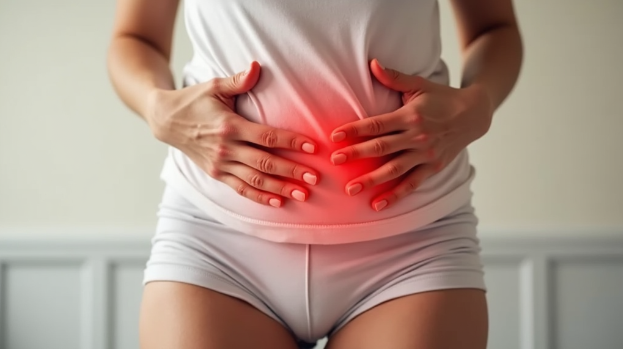Painful and irregular menstrual cycles can be incredibly challenging for many women, often disrupting daily life with physical and emotional discomfort. For some, periods come with intense cramps, back pain, and fatigue, while others face unpredictable cycle lengths, making it difficult to plan or manage routines.
Unfortunately, these menstrual irregularities can sometimes point to underlying health conditions, such as polycystic ovary syndrome (PCOS) or endometriosis, both of which may require medical attention. By understanding the possible causes and exploring treatment options, from lifestyle changes to medical interventions, those affected can work towards finding relief and achieving a more balanced cycle.
Table of Contents
Key Takeaways
- Painful and irregular menstrual cycles can be caused by various factors, including hormonal imbalances, stress, and underlying medical conditions
- Common symptoms include severe cramps, heavy bleeding, and unpredictable periods
- Diagnosis often involves a combination of physical exams, blood tests, and imaging studies
- Treatment options range from lifestyle changes and over-the-counter pain relievers to hormone therapy and surgical interventions
- Seeking medical advice is crucial for proper diagnosis and management of painful and irregular periods
- Hormone optimization therapy can be an effective treatment for some women experiencing menstrual irregularities
Painful and irregular menstrual cycles can significantly impact a woman’s quality of life. These issues are more common than many people realize and can stem from various causes. Understanding the root of the problem is the first step in finding effective solutions.
The Basics of Painful and Irregular Menstrual Cycles

A typical menstrual cycle lasts between 21 to 35 days, with bleeding usually lasting 2 to 7 days. However, many women experience cycles that deviate from this norm, leading to what’s known as irregular periods. Painful periods, or dysmenorrhea, can range from mild discomfort to severe pain that interferes with daily activities.
What Constitutes an Irregular Period?
Irregular periods can manifest in several ways:
- Cycles shorter than 21 days or longer than 35 days
- Missed periods
- Unpredictable timing of periods
- Varying duration of bleeding
- Spotting between periods
Understanding Menstrual Pain
While some discomfort during menstruation is normal, excessive pain is not. Severe menstrual cramps that disrupt daily life warrant medical attention. This type of pain is often described as:
- Throbbing or cramping in the lower abdomen
- Pain that radiates to the lower back and thighs
- Nausea and vomiting
- Dizziness or fainting
Common Causes of Painful and Irregular Menstrual Cycles
Several factors can contribute to painful and irregular menstrual cycles. Understanding these causes is crucial for proper management and treatment.
Hormonal Imbalances
Hormones play a vital role in regulating the menstrual cycle. Imbalances in estrogen and progesterone levels can lead to irregular periods and increased pain. Conditions like polycystic ovary syndrome (PCOS) and thyroid disorders can disrupt hormone balance and affect menstruation.
Endometriosis
Endometriosis is a condition where tissue similar to the uterine lining grows outside the uterus. This can cause severe pain during periods and lead to irregular bleeding patterns. Women with endometriosis often experience pain during intercourse and may have difficulty conceiving.
Uterine Fibroids
Uterine fibroids are non-cancerous growths in the uterus that can cause heavy bleeding and painful periods. These growths can vary in size and number, affecting the regularity and flow of menstrual cycles.
Pelvic Inflammatory Disease (PID)
PID is an infection of the reproductive organs that can cause irregular bleeding and pelvic pain. It’s often a result of sexually transmitted infections and can lead to long-term complications if left untreated.
Stress and Lifestyle Factors
High stress levels, poor diet, and lack of exercise can all contribute to menstrual irregularities. Stress hormones can interfere with the body’s natural hormone balance, leading to changes in menstrual patterns and increased pain sensitivity.
Diagnosing Painful and Irregular Periods

Proper diagnosis is essential for effective treatment of menstrual irregularities. Healthcare providers use a combination of methods to determine the underlying cause of symptoms.
Medical History and Physical Examination
The first step in diagnosis is usually a thorough medical history and physical exam. Your doctor will ask about your menstrual patterns, pain levels, and any other symptoms you’re experiencing. They may also perform a pelvic exam to check for any visible abnormalities.
Blood Tests
Blood tests can help identify hormonal imbalances, thyroid issues, or other systemic problems that might be affecting your menstrual cycle. These tests may include:
- Hormone level checks (estrogen, progesterone, testosterone)
- Thyroid function tests
- Complete blood count to check for anemia
Imaging Studies
Imaging techniques can provide valuable information about the structure of your reproductive organs. Common imaging studies include:
- Ultrasound: To visualize the uterus, ovaries, and detect fibroids or cysts
- MRI: For a more detailed look at soft tissues, especially useful in diagnosing endometriosis
- Hysterosalpingogram: An X-ray procedure to examine the uterus and fallopian tubes
Laparoscopy
In some cases, a minimally invasive surgical procedure called laparoscopy may be necessary. This allows the doctor to directly visualize the pelvic organs and diagnose conditions like endometriosis that may not be visible on imaging studies.
Treatment Options for Painful and Irregular Periods

Treatment for painful and irregular periods depends on the underlying cause and the severity of symptoms. Options range from lifestyle changes to medical interventions.
Lifestyle Modifications
Simple changes in daily habits can sometimes alleviate menstrual issues:
- Regular exercise to improve circulation and reduce stress
- A balanced diet rich in fruits, vegetables, and whole grains
- Stress reduction techniques like meditation or yoga
- Adequate sleep and rest during menstruation
Over-the-Counter Pain Relief
For mild to moderate menstrual pain, over-the-counter pain relievers can be effective:
- Nonsteroidal anti-inflammatory drugs (NSAIDs) like ibuprofen or naproxen
- Acetaminophen for pain relief without anti-inflammatory effects
Hormonal Treatments
Hormonal therapies can help regulate menstrual cycles and reduce pain:
- Birth control pills to regulate hormone levels and reduce heavy bleeding
- Hormonal IUDs that can lighten or stop periods altogether
- Progesterone supplements to balance hormone levels
Surgical Interventions
In severe cases or when other treatments fail, surgical options may be considered:
- Endometrial ablation to reduce heavy bleeding
- Myomectomy to remove uterine fibroids
- Hysterectomy as a last resort for severe, uncontrollable symptoms
The Role of Hormone Optimization Therapy

Hormone optimization therapy is an emerging treatment option for women experiencing menstrual irregularities due to hormonal imbalances. This approach aims to restore optimal hormone levels, potentially alleviating symptoms and improving overall well-being.
Benefits of Hormone Optimization
- Regulation of menstrual cycles
- Reduction in menstrual pain
- Improved mood and energy levels
- Enhanced fertility in some cases
Customized Treatment Plans
Hormone optimization therapy is tailored to each individual’s specific needs. Treatment may involve:
- Bioidentical hormone replacement
- Targeted supplementation
- Lifestyle modifications to support hormone balance
When to Seek Medical Help
While some variation in menstrual cycles is normal, certain signs warrant medical attention:
- Periods that last longer than 7 days
- Cycles shorter than 21 days or longer than 35 days
- Heavy bleeding that soaks through a pad or tampon every hour for several hours
- Severe pain that interferes with daily activities
- Bleeding between periods or after menopause
Managing Painful and Irregular Periods at Home
In addition to medical treatments, there are several ways to manage menstrual symptoms at home:
Heat Therapy
Applying heat to the lower abdomen can help relieve menstrual cramps. Use a heating pad or take a warm bath to ease discomfort.
Gentle Exercise
Light physical activity, such as walking or stretching, can improve blood flow and reduce pain. However, avoid intense workouts during heavy-flow days.
Dietary Changes
Some women find relief by adjusting their diet during menstruation:
- Reducing salt intake to minimize bloating
- Increasing intake of foods rich in omega-3 fatty acids
- Avoiding caffeine and alcohol, which can worsen cramps
Relaxation Techniques
Stress can exacerbate menstrual symptoms. Practicing relaxation methods like deep breathing or progressive muscle relaxation can help manage pain and reduce anxiety.
The Impact of Painful and Irregular Periods on Quality of Life

Painful and irregular menstrual cycles can significantly affect a woman’s daily life, impacting work, relationships, and overall well-being.
Work and Productivity
Severe menstrual pain can lead to missed workdays or reduced productivity. Some women may feel uncomfortable discussing these issues with employers, which adds stress.
Social and Romantic Relationships
Unpredictable periods and pain can interfere with social plans and intimate relationships. Open communication with partners and friends about these challenges is important.
Mental Health
The physical discomfort and unpredictability of irregular periods can take a toll on mental health, potentially leading to anxiety or depression in some cases.
Long-Term Outlook and Management
Managing painful and irregular periods often requires ongoing care and adjustment of treatment plans. Regular check-ups with a healthcare provider are essential for monitoring progress and making necessary changes to management strategies.
Tracking Symptoms
Keeping a menstrual diary can be helpful for both patients and healthcare providers. Track the following:
- Start and end dates of periods
- Flow intensity
- Pain levels
- Other symptoms like mood changes or bloating
Adapting to Changes
As women age or experience life changes like pregnancy or menopause, menstrual patterns may shift. Being prepared to adapt treatment approaches is key to long-term management.
Emerging Research and Treatments
The field of women’s health is constantly evolving, with new research shedding light on menstrual disorders and potential treatments.
Genetic Factors
Recent studies have begun to explore genetic links to conditions like endometriosis and PCOS, which may lead to more targeted treatments in the future.
Nutritional Approaches
Research into the role of nutrition in menstrual health is ongoing, with some studies suggesting that certain dietary patterns may help alleviate symptoms.
Advanced Pain Management Techniques
New pain management strategies, including nerve stimulation devices and novel medications, are being developed to provide better relief for severe menstrual pain.
The Importance of Women’s Health Education

Improving education about menstrual health is crucial for early detection and management of problems. Many women suffer in silence, unaware that their symptoms are treatable.
Breaking the Stigma
Open discussions about menstrual health can help break down societal taboos and encourage women to seek help when needed.
Empowering Women Through Knowledge
Providing accurate, accessible information about menstrual health empowers women to make informed decisions about their bodies and advocate for their healthcare needs.
Conclusion
Painful and irregular menstrual cycles are common but not normal. With proper diagnosis and treatment, most women can find relief and improve their quality of life. Whether through lifestyle changes, medical interventions, or hormone optimization therapy, there are numerous options available to manage these conditions effectively.
Women need to listen to their bodies, track their symptoms, and seek medical advice when needed. Women can work towards achieving regular, pain-free cycles and overall well-being by taking an active role in their menstrual health.
| Symptom | Possible Causes | When to Seek Help |
|---|---|---|
| Heavy bleeding | Fibroids, hormonal imbalances, endometriosis | Soaking through a pad/tampon every hour for 2+ hours |
| Severe pain | Endometriosis, adenomyosis, PID | Pain interferes with daily activities |
| Irregular cycles | PCOS, thyroid disorders, stress | Cycles consistently shorter than 21 or longer than 35 days |
| Spotting between periods | Hormonal imbalances, cervical issues | Persistent spotting for several cycles |
| Missed periods | Pregnancy, PCOS, extreme stress | No period for 3+ months (if not on birth control) |
| Treatment Option | Benefits | Potential Side Effects |
|---|---|---|
| Birth control pills | Regulates cycles, reduces heavy bleeding | Nausea, breast tenderness, mood changes |
| Hormone optimization therapy | Balances hormones, improves overall well-being | Varies based on individual treatment |
| NSAIDs | Reduces pain and inflammation | Stomach upset, increased bleeding risk |
| Endometrial ablation | Reduces or stops heavy bleeding | Cramping, discharge, inability to carry future pregnancies |
| Lifestyle changes (diet, exercise) | Natural approach, overall health benefits | Minimal side effects, may take time to see results |
- Natural remedies for menstrual pain relief:
- Ginger tea for reducing inflammation and cramps
- Chamomile tea for its calming and anti-spasmodic effects
- Magnesium-rich foods like dark chocolate and nuts to ease muscle tension
- Essential oils such as lavender or clary sage for aromatherapy
- Acupressure or massage to relieve tension and improve blood flow
If you’re experiencing painful and irregular menstrual cycles, it’s time to take control of your health. At Revv Health, we understand how debilitating these symptoms can be, and we’re here to help. Our expert team is committed to providing personalized care and effective treatments to restore balance and bring relief.
Don’t suffer in silence—reach out today to schedule your consultation and take the first step toward a healthier, more comfortable you. Your well-being is our priority, and we’re ready to support you every step of the way.


